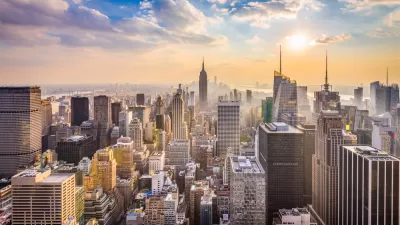Despite fears of a mass exodus, most cities are seeing only modest population losses, with the majority of movers staying in the same metro area.

Rather than the "urban exodus" that many analysts feared the pandemic would precipitate, write Marie Patino, Aaron Kessler, and Sarah Holder for Bloomberg CityLab, "perhaps it’s more of an urban shuffle."
As research about the last year begins to crystallize, "data shows most people who did move stayed close to where they came from." According to the authors, "[i]n the country’s 50 most populous cities, 84% of the moves were to somewhere within the perimeter of the central metro area, down just slightly from pre-pandemic levels."
New York City and San Francisco saw more dramatic changes. "The regions around San Francisco and San Jose, two of the country’s most expensive housing markets, saw the rates of permanent moves increase the most, by more than 23% and 17% respectively, compared to 3% nationally." New York City "saw the greatest loss in net moves into the city over the past year" as Manhattan residents relocated to outer boroughs, nearby suburbs like Long Island, and outlying areas like the Bridgeport-Stamford-Norwalk region of Connecticut, less than 60 miles from the city. Some smaller cities are seizing on the opportunity with incentive programs designed to attract remote workers.
But the "release valve" created by the sudden boom in remote work "is not available to the majority of American workers, who can’t work remotely, particularly essential workers and low-wage workers." Knowing the remote work boom may not last, cities like Stockton, "a sizable majority-nonwhite city that’s been deemed the most diverse in America," are focusing instead on attracting companies and job opportunities for existing residents.
FULL STORY: More Americans Are Leaving Cities, But Don’t Call It an Urban Exodus

Alabama: Trump Terminates Settlements for Black Communities Harmed By Raw Sewage
Trump deemed the landmark civil rights agreement “illegal DEI and environmental justice policy.”

Planetizen Federal Action Tracker
A weekly monitor of how Trump’s orders and actions are impacting planners and planning in America.

The 120 Year Old Tiny Home Villages That Sheltered San Francisco’s Earthquake Refugees
More than a century ago, San Francisco mobilized to house thousands of residents displaced by the 1906 earthquake. Could their strategy offer a model for the present?

Ken Jennings Launches Transit Web Series
The Jeopardy champ wants you to ride public transit.

BLM To Rescind Public Lands Rule
The change will downgrade conservation, once again putting federal land at risk for mining and other extractive uses.

Indy Neighborhood Group Builds Temporary Multi-Use Path
Community members, aided in part by funding from the city, repurposed a vehicle lane to create a protected bike and pedestrian path for the summer season.
Urban Design for Planners 1: Software Tools
This six-course series explores essential urban design concepts using open source software and equips planners with the tools they need to participate fully in the urban design process.
Planning for Universal Design
Learn the tools for implementing Universal Design in planning regulations.
Clanton & Associates, Inc.
Jessamine County Fiscal Court
Institute for Housing and Urban Development Studies (IHS)
City of Grandview
Harvard GSD Executive Education
Toledo-Lucas County Plan Commissions
Salt Lake City
NYU Wagner Graduate School of Public Service





























